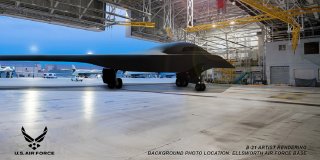Why the U.S. Air Force Really Needs the B-21 Stealth Bomber
The B-21 Raider, named after the Doolittle Raiders of World War II fame, could make its maiden flight sometime in mid-2022, according to reporting by Air Force Magazine. B-21 airframe number one has already completed, with construction on the second airframe already underway.
The B-21 Raider, named after the Doolittle Raiders of World War II fame, could make its maiden flight sometime in mid-2022, according to reporting by Air Force Magazine. B-21 airframe number one has already completed, with construction on the second airframe already underway.
B-21 assembly initially hit logistical roadblocks related to component procurement due to the ongoing pandemic, though parts bottleneck has since been solved and production has continued according to schedule. It is estimated that the Air Force will buy around 150 airframes, but regardless of what final production numbers look like, Air Force officials estimate that the B-21 will enter service in 2026 or 2027.
B-21 Raider, Explained
The B-21 is to fly, at least initially, alongside the United States other strategic bomber aircraft, including the B-2 Spirit bomber (also manufactured by Northrup Grumman), the supersonic B-1 Lancer, and the B-52 Stratofortress.
The B-21’s characteristics are a closely-guarded secret. To date, the B-21 is known only from a couple of artistic digital renderings that have been released by the U.S. Air Force. In the images, the B-21’s general shape can be seen and is strongly reminiscent of Northrup Grumman’s B-2 Spirit stealth bomber, both flying wing designs. Engine air intakes flush with the bomber’s fuselage can also be seen, as can the airframe's nose and part of the outside wing.
Although the B-21 Raider’s general shape is similar to the B-2, they will be substantially different aircraft. The B-21 sports a tricycle-style landing gear assembly like the B-2, though the B-21’s two main wheel assemblies have just two wheels each. This could indicate the B-21’s probable smaller size compared to the B-2, which has four wheels on each of its two rear landing assemblies. Unlike the B-2, which has a sawtooth-shaped tail, the B-21 will likely have a cranked-kite, diamond-shaped rear fuselage, which some experts suggest would optimize the B-21 for stealth at high-altitude.
The B-21 will use a version of the F-35’s engines, possibly up to four of them, helping to keep costs down, and will most likely have a radar absorbant coating that is more robust and less maintenance-intense than the B-2’s. Air Force officials have described the B-21 as extremely low-observable, compared to the F-35 and F-22 stealth fighters which are supposed to be very low-observable. It has also been suggested that the B-21 could fly without a human pilot, though that may be difficult to confirm.
Still, less is known about the B-21’s proposed fighter escort. In the event of a conflict with China, one of the B-21’s likely high priorities would be to target and destroy missile installations in the country’s west that could likely cover China as well parts of the South China Sea and Western Pacific in a missile blanket. In order to penetrate that airspace deep within Chinese territory, the B-21 may need a stealthy fighter escort to accompany it to the target.
Postscript
Once the B-21 enters service in the mid-to late-2020, it will be badly needed. The United States’ bomber force isn’t getting any younger: By 2025, the U.S. Air Force’s B-52s will be over 60 years old, and the only other stealth bomber in USAF service will be nearly 30. The B-21 won't come a moment too soon.
Caleb Larson is a defense writer based in Europe. He holds a Master of Public Policy and covers U.S. and Russian security, European defense issues, and German politics and culture.


